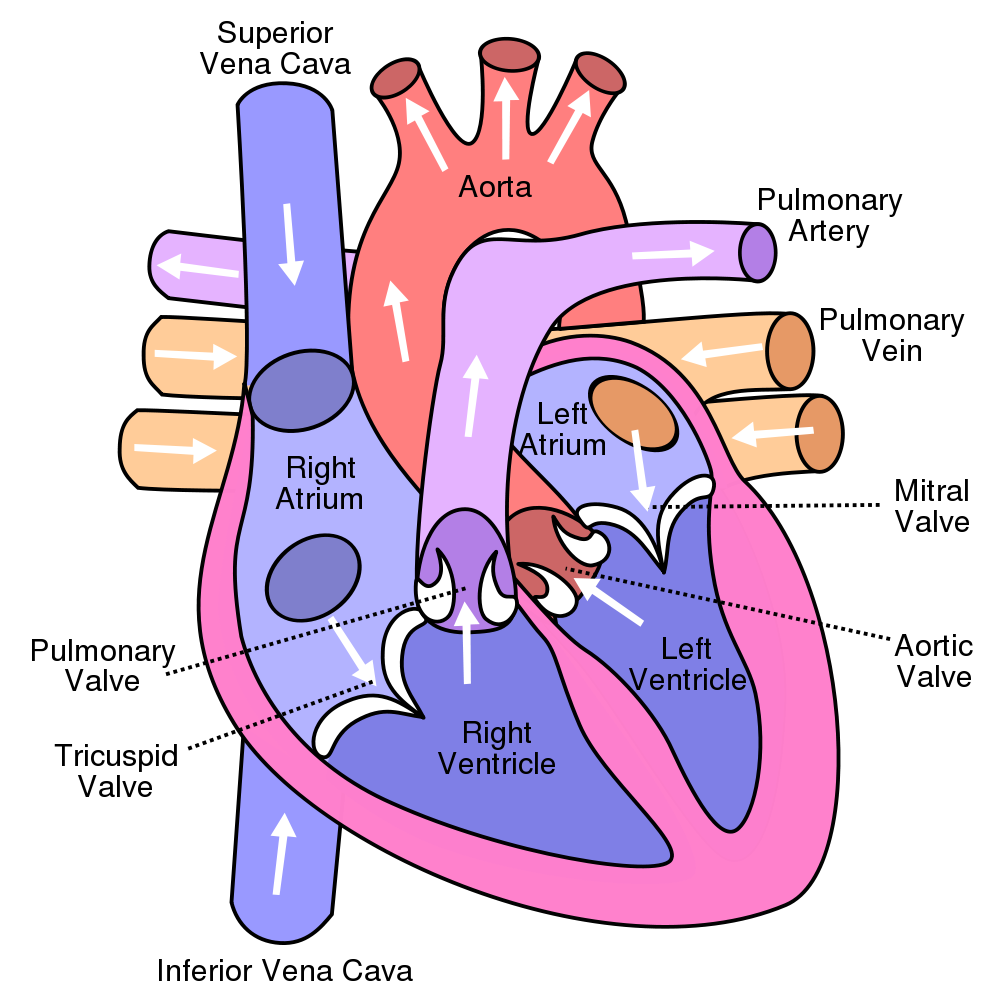Canine Heart Disease and Nutrition: Part 1
Types of Heart Disease in Dogs
Heart disease in dogs falls into two major categories, those that affect the heart muscle and those that affect the heart valves. Heart disease involving the pericardium, the thin sack that surrounds the heart, is much less common. By far the most common abnormalities are congenital and age related valvular heart disease.
As the diagram below shows, the heart has four chambers separated by a wall and two valves.
The valve separating the right atrium from the left atrium is called the tricuspid valve and the one separating the chambers on the left side is called the mitral valve. Between beats blood flows passively into the atria and through the valves into the ventricles. When the heart contracts, or “beats,” pressure inside the ventricles increases and the tricuspid and mitral valves close. The trapped blood in the ventricles is ejected from the heart into the pulmonary artery and the aorta to the lungs and the rest of the body. As the heart relaxes after contraction, the increased pressure in the pulmonary artery and the aorta causes the pulmonary and aortic valves to close so blood does not flow back into the ventricles as they fill for the next contraction. The blood from the right atrium and ventricle is blood that has circulated the body and lost its oxygen supply and is pumped to the lungs for more. Oxygenated blood returns to the left atrium and ventricle for distribution throughout the body.
Canine valvular disease (CVD) results from the faulty closing of the valve during heart contractions. This allows some of the ventricular blood to flow back into the atrium instead of to the lungs or body. This regurgitation of blood into the atria creates a distinct sound called a murmur. Birth defects or congenital valve conditions can occur to any of the four valves but are more common for the tricuspid and mitral. Age related murmurs are more commonly associated with the mitral valve. This valvular insufficiency results in blood "backing up" into the vena cava veins (deoxygenated blood returning from the body tissues) or the lungs. As the pressure builds from the blood accumulation, fluid leaks from the vessels.
If the tricuspid valve is faulty fluid accumulates in the abdomen, liver and other organs. In late stages of disease these animals may have swollen abdomens. If the mitral valve is the culprit, then fluid accumulates in the lungs. Affected animals cough, particularly at night. The cough often sounds "moist" and "productive" and they will gag after a coughing spell due to the phlegm they have coughed up. These pets are often restless at night and cannot lie on their sides for very long. They often tire easily during exercise.
To compensate for its dysfunction, the heart enlarges to pump more blood and satisfy body tissue needs. The ever expanding heart makes symptoms worse and creates a downward spiral toward congestive heart failure.
The symptoms of heart muscle disease are very similar. Only 5-10 percent of dogs have this condition. The boxer is the most notable breed in this category. Other large or giant breeds like Dobermans and Great Danes are also predisposed. The difference is that blood pumping dysfunction is a result of heart muscle abnormalities. The heart is generally larger than normal but the walls are thinner, hence the name Dilated Cardiomyopathy, or DCM. Ventricular contractions are weak so blood flow is reduced. Again, the compensation for cardiac enlargement exacerbates the condition. Unlike valvular disease, this condition also affects the pacemakers of the heart.
In addition to the symptoms listed above, dogs with DCM suffer from disruptive, abnormal heart rhythms that result in inconsistent blood flow, called pulse deficits. This can cause "fainting spells," anorexia (lack of appetite), and vomiting. These arrhythmias are often distinct and easily detected during physical exams.
CVD and DCM cannot be cured at this time and are eventually fatal, with DCM having the worst prognosis. The conditions are managed by various drugs. Nutritional changes have also been a mainstay of management.
Next week we will look at nutritional considerations for the heart patient and some of the newer supplements used for these conditions.

Dr. Ken Tudor
Images:
Diagram of the human heart / via Wikimedia Commons
Petr Jilek / via Shutterstock
Explore More at petMD.com:
Canine Heart Disease and Nutrition: Part 2
Pet Nutrition in People Terms: Weight Gain
The Benefits of Proper Nutrition

